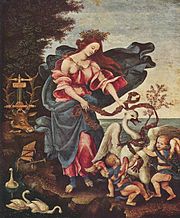The history of music predates the written word. The development of music among humans must have taken place against the backdrop of natural sounds such as birdsong and the sounds other animals use to communicate.[citation needed] Prehistoric music is the name given to all music produced in preliterate cultures.[citation needed][1]
Ancient
A range of paleolithic sites have yielded bones in which lateral holes have been pierced: these are usually identified as flutes[2], blown at one end like the Japanese shakuhachi. The earliest written records of musical expression are to be found in the Sama Veda of India and in 4,000 year old cuneiform from Ur.[citation needed] Instruments, such as the seven-holed flute and various types of stringed instruments have been recovered from the Indus valley civilization archaeological sites.[3] India has one of the oldest musical traditions in the world—references to Indian classical music (marga) can be found in the ancient scriptures of the Hindu tradition, the Vedas. The traditional art or court music of China has a history stretching for more than three thousand years. Music was an important part of cultural and social life in Ancient Greece: mixed-gender choruses performed for entertainment, celebration and spiritual ceremonies; musicians and singers had a prominent role in ancient Greek theater; music was part of children's basic education.[citation needed]
Al-Farabi (c. 872 - c. 950) wrote a notable book on music titled Kitab al-Musiqi al-Kabir ("Great Book of Music"). He played and invented a variety of musical instruments and devised the Arab tone system of pitch organisation, which is still used in Arabic music.[4]
Medieval and Renaissance Europe
While musical life in Europe was undoubtedly rich in the early Medieval era, as attested by artistic depictions of instruments, writings about music, and other records, the only European repertory which has survived from before about 800 is the monophonic liturgical plainsong of the Roman Catholic Church, the central tradition of which was called Gregorian chant. Several schools of liturgical polyphony flourished in the period after about 1100. Alongside these traditions of sacred music, a vibrant tradition of secular song developed, exemplified by the music of the troubadours, trouvères and Minnesänger.
Much of the surviving music of 14th century Europe is secular. By the middle of the 15th century, composers and singers used a smooth polyphony for sacred musical compositions such as the mass, the motet, and the laude, and secular forms such as the chanson and the madrigal. The introduction of commercial printing had an immense influence on the dissemination of musical styles.[citation needed]
European Baroque
The first operas, written around 1600 and the rise of contrapuntal music define the end of the Renaissance and the beginning of the Baroque era that lasted until roughly 1750, the year of the death of Johann Sebastian Bach.


German Baroque composers wrote for small ensembles including strings, brass, and woodwinds, as well as Choirs, pipe organ, harpsichord, and clavichord. During the Baroque period, several major music forms were defined that lasted into later periods when they were expanded and evolved further, including the Fugue, the Invention, the Sonata, and the Concerto.[5]
European Classical
The music of the Classical period is characterized by homophonic texture, often featuring prominent melody with accompaniment. These new melodies tended to be almost voice-like and singable. The now popular instrumental music was dominated by further evolution of musical forms initially defined in the Baroque period: the sonata, and the concerto, with the addition of the new form, the symphony. Joseph Haydn and Wolfgang Amadeus Mozart, well known even today, are among the central figures of the Classical period.

No comments:
Post a Comment